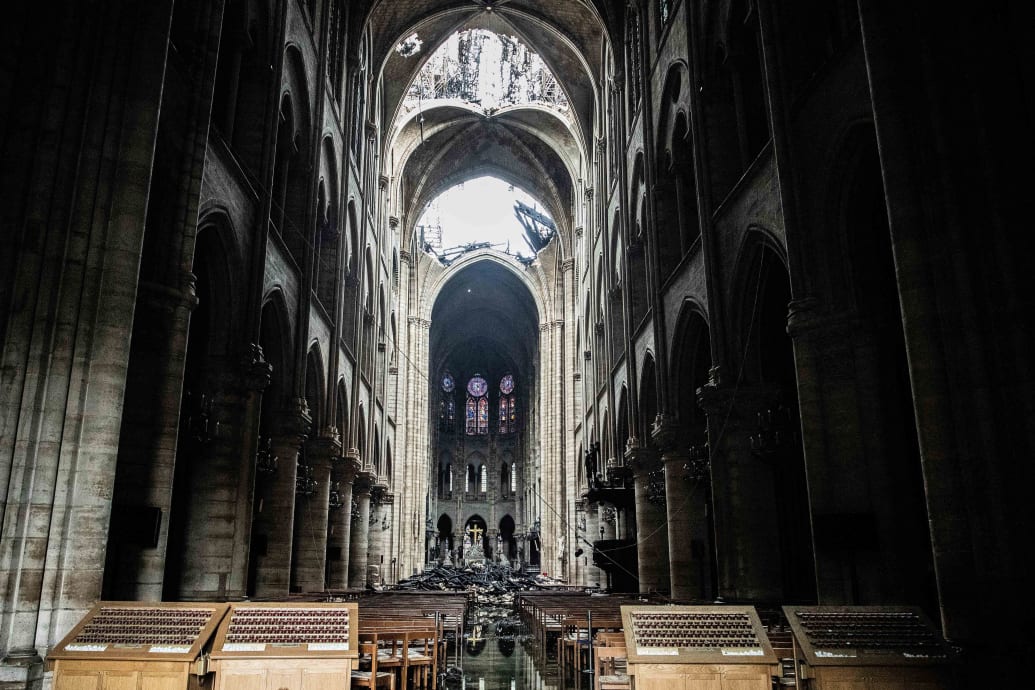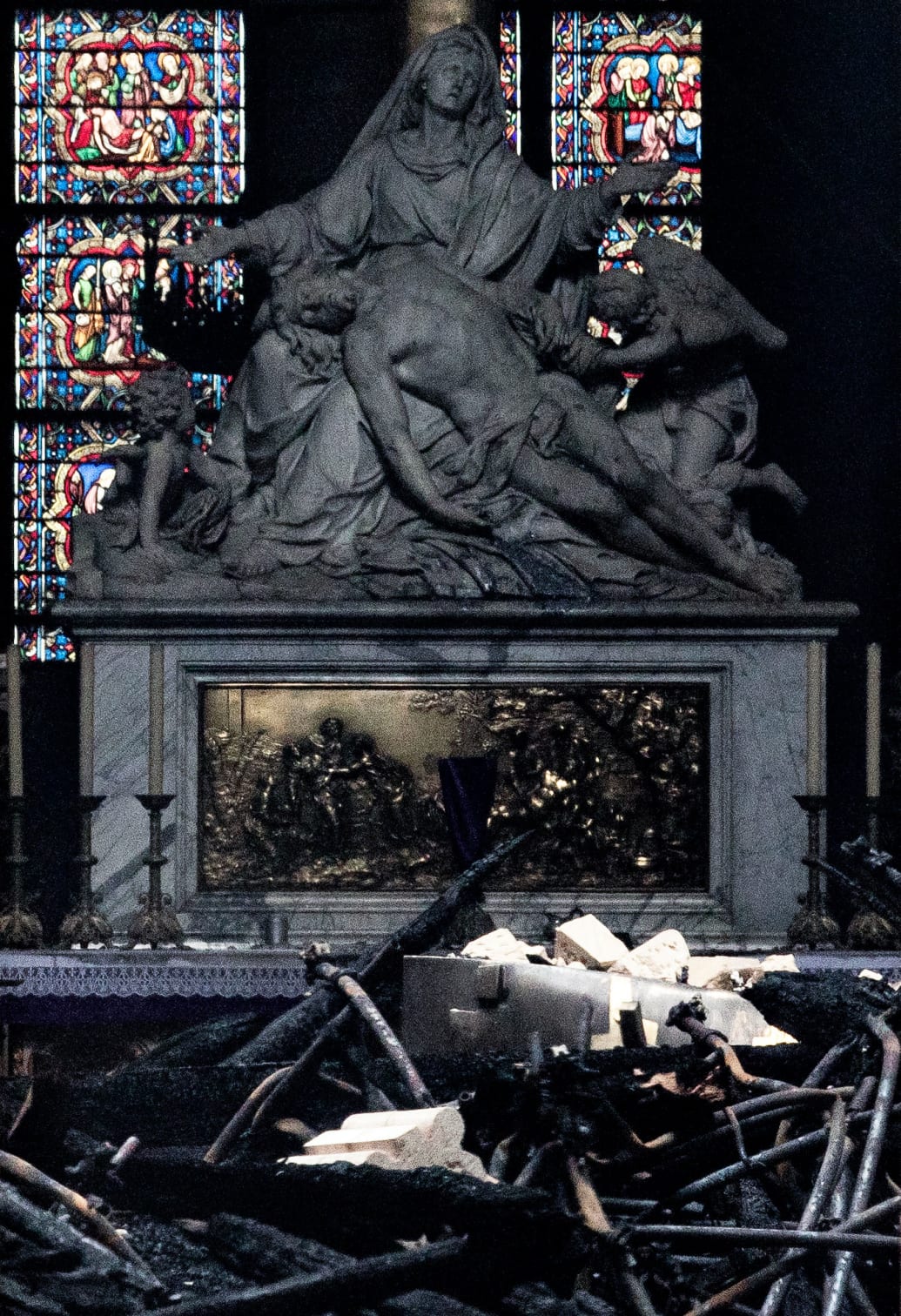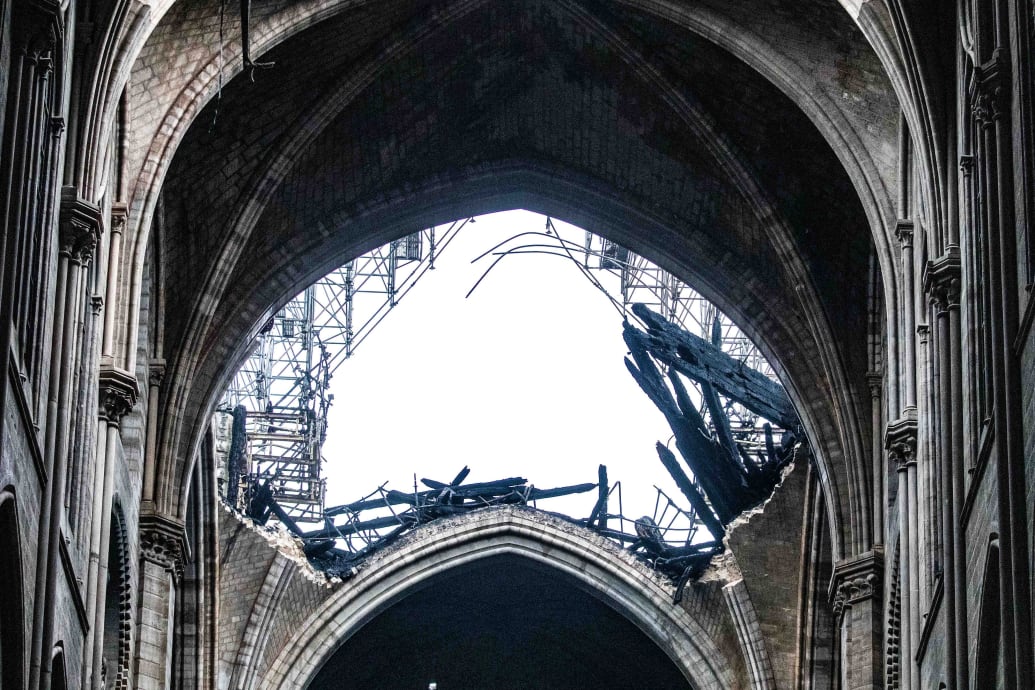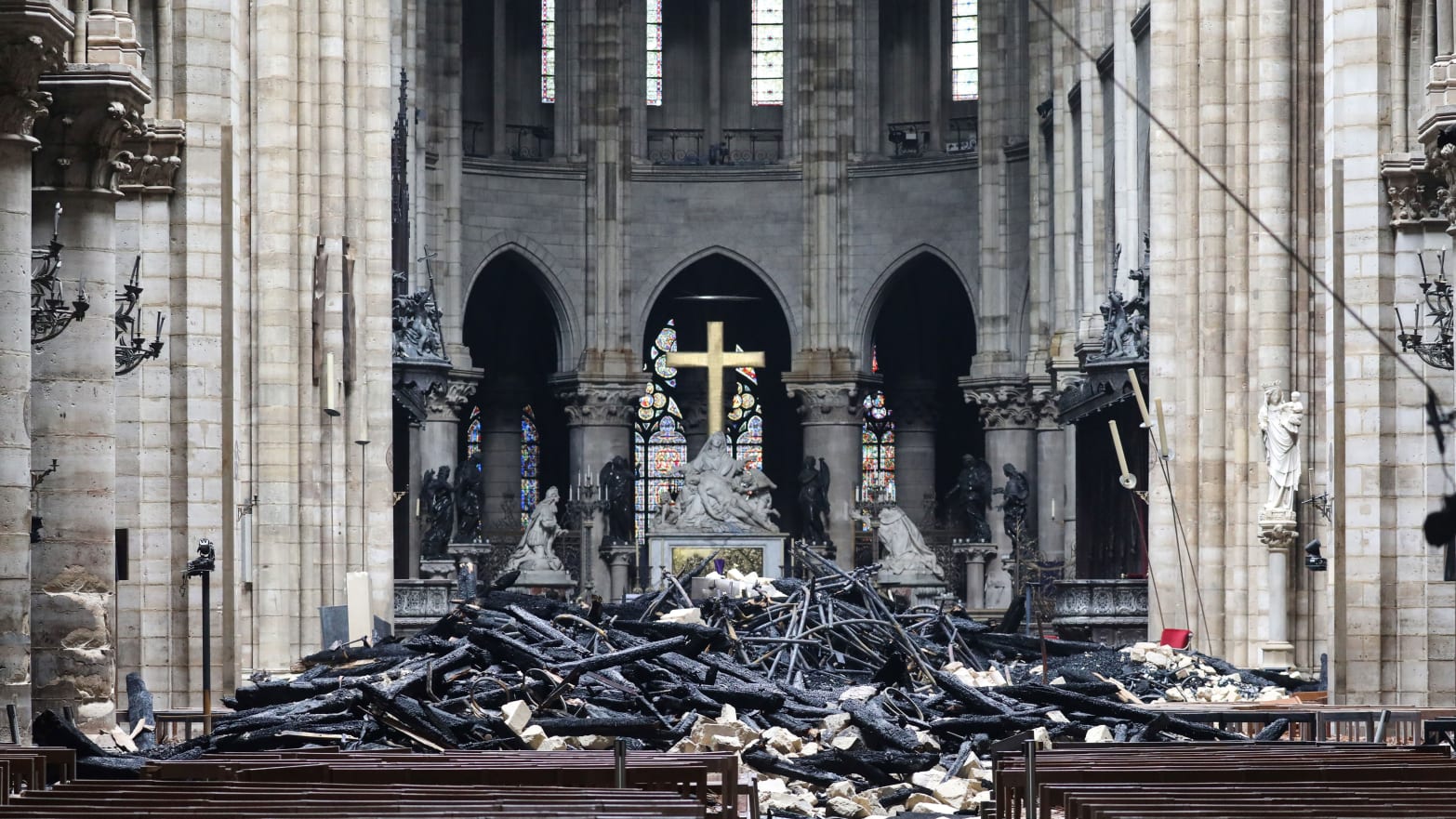PARIS—An alarm was raised at Notre Dame at 6:20 p.m. on Monday night—23 minutes before the structure was engulfed in flames—but officials found no sign of a fire.
Firefighters who responded to a second alert raced to the scene but were then unable to tame an inferno that ripped through the 12th century cathedral for the next 9 hours.
Paris public prosecutor Rémy Heitz announced on Tuesday that a full investigation would uncover how a massive fire was allowed to gut the cathedral.
“What we know at this stage is that there was an initial alarm at 6:20 p.m., followed by a procedure to verify this but no fire as found,” Heitz explained. “Then, there was a second alarm at 6:43 p.m. and at that point a fire was detected in the structure.”

Fallen debris from the burnt out roof structure sits near the altar inside Notre Dame Cathedral in Paris, France, on Tuesday, April 16, 2019.
Christophe Morin/Bloomberg via Getty
“The investigation is going to be long and complex,” he added. “We are in the process of interviewing witnesses.” Investigators have identified and interviewed some of the construction crew who had been working on the €6 million ($6.8 million), four-year renovation project, which began last April.
The restoration of the spire, which crumbled within the first hour of the blaze, was the first phase of a larger, 20-year renovation project on the rest of the cathedral. According to Heitz, some five different construction companies were involved in the ongoing restoration of the cathedral’s iconic spire. The work was being overseen by Le Bras Frères, which specializes in the restoration of historic monuments. Prior to the start of the Notre Dame project, the company had already worked on several of France’s historical churches, including those in Amiens, Reims, and Poitiers.
Meanwhile, the government has launched a national call for donations to repair the cathedral. French billionaires led the way in pledging hundreds of millions of dollars in the reconstruction effort: Tycoon François-Henri Pinault announced that he would donate €100 million. On Tuesday, the family of his arch-rival, Bernard Arnault, who owns the luxury group LVMH, announced a €200 million donation. Others raised the total to nearly $700 million, including $50 million from the City of Paris.
President Emanuel Macron pledged to rebuild the Notre Dame within five years, he said during a national address Tuesday night.
Doubts still remain about the integrity of the Gothic stone building. Two-thirds of the timber roof is gone—it had been crafted from more than 13,000 oak trees, an entire forest reduced to kindling. Preliminary images of the devastated interior reveal a gaping hole where the 300-foot wooden spire once stood and smoke rising from the ashes of burning pews.
French Culture Minister Franck Riester said that most of the priceless artworks in the building had been saved.
“The main structure has been saved but there is still a lot of instability,” Riester told a local radio station. “The situation is still precarious. The two belfries and the works were saved, including the treasure, thanks to the courage of the Paris fire brigade.”
Some of the artifacts, including the cathedral’s medieval Grand Organ, were slightly damaged, but not beyond repair. “All night I was crossing my fingers that the cornerstones wouldn’t fall on the instrument,” Notre Dame’s organist, Vincent Dubois said. “It's a miracle and we are delighted.”
When the devastating fire broke out, firefighters and employees of French Culture Ministry formed a human chain to rescue as many of the cathedral's priceless artifacts and treasures as possible.
“When a fire occurs at a cultural site, a plan to save its treasures is immediately put in place,” Paris Fire Brigade commander, General Jean-Claude Gallet, told local French television station BFMTV. “It's not only necessary to fight the fire, but also to preserve the works of art.”
Their efforts paid off, and several iconic artifacts, including the Crown of Thorns purported to have been worn by Jesus Christ during the crucifixion– along with what is believed to be portion of the cross and an original nail–were safely evacuated from the building. The blessed sacrament, a tunic worn by Louis the 13th, and several paintings, including a 17th-century work by French painter, Lubin Baugin, were rescued.

The interior of the Notre-Dame Cathedral is seen through a doorway following a major fire yesterday on April 16, 2019 in Paris, France.
Dan Kitwood/Getty
“These treasures were saved,” Notre Dame spokesperson André Finot told FranceInfo. The artifacts were first transported to a safe place in the city’s nearby Hôtel de Ville, then later moved to the Louvre Museum for safe-keeping.
The Rose Windows – the immense round stained glass windows over Notre Dame's three principal portals – also escaped the flames without major damage. The building’s legendary twin bell towers survived as well, as did Nicolas Coutou's 18th-century marble masterpiece ‘La Pieta’ sculpture behind the church’s main altar.
Sixteen bronze statues surrounding the collapsed spire are still intact thanks to miraculous timing rather than divine intervention. The figures, depicting the 12 apostles and four evangelists, were removed from the roof just days before the fire as part of the extensive renovation.
Still, not everything escaped the fire. A number of large oil paintings that could not be removed from the high walls sustained damage and will be restored at the Louvre, according to Le Monde. Other religious treasures, including a separate piece of the Crown of Thorns, as well as relics of Saint-Denis and Saint-Geneviève are gone forever. All three were stored inside the copper Gallic rooster that crowned the spire that collapsed about an hour into the inferno.
On Tuesday, the plaza in front of the cathedral, usually bisected with a long line of tourists waiting for the doors to open, was closed as firefighters continued their work. Fire hoses snaked outside and a cherry picker extended from the back of a red truck to one of the damaged towers.
“This is a very meaningful spot for me,” said Heidi Waterfall, an American living in in Paris. “I feel a strong spiritual power when I go inside. I feel peace and joy.”
The South Dakota native had watched in stunned silence, tears rolling down her face, as the cathedral burned and then she heard a chorus she will never forget, the strains of people singing the Hail Mary. Whenever friends visit, the family takes them to see the cathedral. “My middle son always grumbled to go, but last night he said, ‘I’d give anything to go back one more time’,” she said.
Tourists snapped photos of the blank space between the towers where the famous spire once stood. Many of them had seen it topple the night before as the fire raged.
Along the left and right banks of the Seine, people stopped to take in the scene as charred rose windows towered above the rows of flowering trees that never lost their new pink blossoms.

Daylight shines through the fallen roof structure of Notre Dame Cathedral following the fire in Paris, France, on Tuesday, April 16, 2019.
Christophe Morin/Bloomberg via Getty Images
That the tragedy happened during Easter week was particularly painful for Rev. Aidan Troy, who was scheduled to join a holy Mass on Wednesday night at Notre Dame and who stood with the masses and watched the landmark burn. “This is the most poignant week of the Christian year,” he said. The loss of the city’s main cathedral will be a disappointment for some 400 believers set to be inducted into the Catholic church with rites on Easter, many of them before the altar at Notre Dame.
Father Troy, the staff priest at St. Joseph’s Catholic Church of Paris, said he noticed a shift in the mood today.
“Last night was devastation and shock and this morning, people seem to be rising,” he said. He said he hoped he would live to see the next chapter of the cathedral that has endured so many over the ages. “Certainly the coming generations will see it,” he said.
Victor Hugo, who helped propel Notre Dame to international fame through his 1831 book The Hunchback of Notre Dame, famously described the cathedral as a “vast symphony in stone.” Sigmund Freud said that the building had a ”majestic presence.”
It is at once both a symbol of Catholicism and French culture.
“You can destroy Notre Dame,” Monsignor Michel Aupetit said Monday night. “But you can’t destroy the soul of Paris.”


